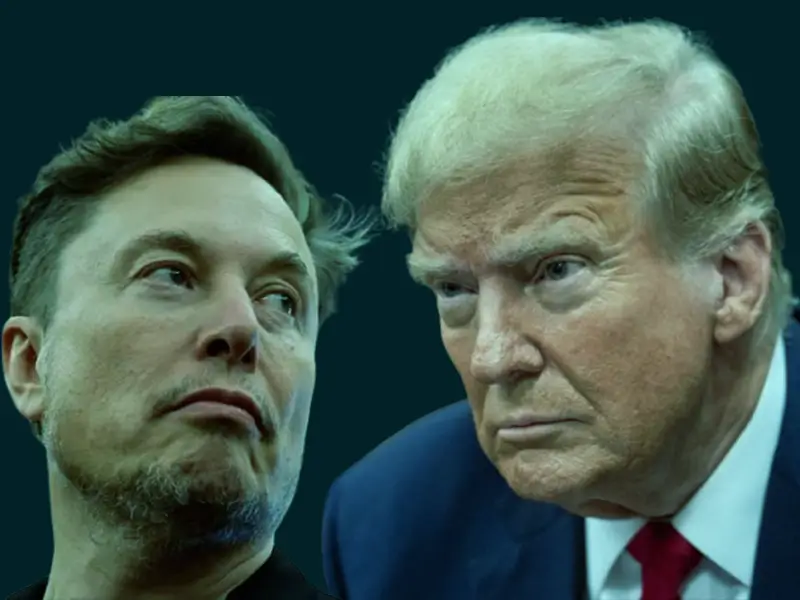How the Trump-Elon Relationship Reached a Breaking Point – The Timeline
The beginning of June 2025 will likely be remembered as a historic turning point—the moment when the once-powerful alliance between U.S. President Donald Trump and billionaire Elon Musk collapsed beyond repair.
Just days earlier, such a rupture seemed unthinkable. Musk had been one of Trump’s most influential backers, pouring millions into his reelection campaign and helping him secure a second term. In return, Trump rewarded Musk with unprecedented influence inside the administration.
At the heart of that reward was the creation of a brand-new federal agency: the Department of Government Efficiency. Its mission was to cut wasteful spending across the U.S. government. Musk, handed full control, moved fast—firing hundreds of federal employees and pushing sweeping reforms.
Even when Musk’s aggressive moves caused Tesla’s stock to dip, Trump stood by him. He hosted Musk at the White House, even test-driving one of Tesla’s newest models on the South Lawn. The 47th President publicly urged his supporters to rally behind Tesla, framing it as a symbol of American innovation.
All of this made the eventual fallout feel surreal. To many, the Trump-Musk alliance looked rock solid. But cracks had already started to show—subtle at first—in mid-May 2025.
Here’s another twist that makes this saga even more dramatic: Musk didn’t even support Trump in the beginning. In fact, he was a vocal critic.
Musk was once a Democrat—openly, and unapologetically. He opposed Trump’s first campaign, dismissed his leadership style, and called him unfit for office. So how did he go from critic to confidant, and then to adversary again? Let’s trace the full arc.
Elon’s Early Opposition to Trump
Born in South Africa, Musk immigrated to Canada, and eventually to the United States in the 1990s, where he built his empire. His early political leanings were predictable—he gravitated toward the Democratic Party, which traditionally embraced immigration and science-forward policy.
At the time, Trump hadn’t yet entered politics. But when Trump launched his first presidential campaign in 2016, Musk was unimpressed. In an interview with CNBC, he criticized Trump directly, saying he lacked the temperament and vision to be a good leader for America.
The First Meeting
Musk’s shift toward Trump didn’t begin with ideology—it began with influence.
Peter Thiel, a longtime ally of Musk and early investor in SpaceX, was one of Silicon Valley’s few Trump supporters. Thiel used his connections to bring Musk into the fold. When Trump won the 2016 election, he summoned the tech world’s top executives to a high-profile meeting in New York City.
Elon Musk was there, alongside Satya Nadella (Microsoft), Tim Cook (Apple), Larry Page (Google), and Jeff Bezos (Amazon). After the group session, Trump held a private one-on-one with Musk.
According to Walter Isaacson’s biography Elon Musk, Musk walked away thinking Trump was a crazy kind of character. But there was a strange rapport—one that would evolve over time. Trump told the media he liked Musk. Musk, in turn, softened his tone.
Soon after Trump’s inauguration, he formed a business advisory council. Musk joined. But it didn’t last. When Trump pulled out of the Paris Climate Agreement in 2017, Musk publicly broke ranks.
He tweeted, Climate change is real. Exiting the Paris Agreement is bad for America and the world. He resigned from the council.
Still, his companies thrived. SpaceX secured multi-billion-dollar government contracts, particularly from NASA. Musk may have stepped away from Trump politically—but he remained connected to the system.
From Détente to Devotion
Over the years, Musk’s own ideology began to shift. He became more vocal in criticizing Democrats, especially around issues of free speech, regulation, and what he saw as excessive political correctness. By the time Trump launched his 2024 campaign, Musk was no longer sitting on the fence—he was firmly in Trump’s corner.
He donated generously, used his platforms to amplify Trump’s talking points, and eventually became one of the most influential non-official voices around the new administration.
In return, Trump treated Musk like a trusted advisor. The Department of Government Efficiency was just one example. Musk began to operate not just as a businessman, but as a policymaker—an unelected one.
The Fallout
So what went wrong?
That’s the part we’re still uncovering. But early signs of tension were already there in May 2025.
Disagreements over policy, clashing egos, and behind-the-scenes power struggles all contributed to the blowup.
Now, what was once a bromance of billionaires has turned into a bitter feud—one that may shape both the future of American politics and the tech world for years to come.
Trump Also Praised Elon Musk in 2020.
He called Musk “one of the brightest minds in our country.” At the time, the relationship between Elon and the Democratic Party was still intact — but not for long.
Withdrawing Support for Democrats
By May 2022, Musk publicly announced he was withdrawing his support for the Democrats, accusing the party of fostering division and hate. He declared that moving forward, he would vote Republican.
This wasn’t just talk. In 2020, he had voted for President Joe Biden. He still didn’t trust Trump. But that was starting to change.
The Rift Begins
By July 2022, signs of friction between Trump and Elon began to surface. At a rally, Trump accused Musk of misleading people and suggested that his companies would collapse without government support. In response, Musk openly stated that Trump should not be re-elected.
Still, Elon remained tactically balanced. After Trump was banned from Facebook and Twitter following the January 6 Capitol riots, Elon — who had purchased Twitter in 2022 — reinstated Trump’s account later that year.
Musk Bets on DeSantis
By 2023, Elon had drifted further from Trump but didn’t return to the Democrats either. Instead, he threw his weight behind Florida Governor Ron DeSantis. The two even appeared together in a Twitter livestream.
At that point, the Republican nominee hadn’t been finalized. Musk made it clear: he wanted DeSantis, not Trump, to lead the party.
The Turn: July 13, 2024
Everything changed on July 13, 2024.
That day, Trump was shot at a campaign rally in Butler, Pennsylvania. The bullet grazed his earlobe, but he stood up inside the Secret Service ring, raised his fist, and shouted — “Fight, fight!”
The moment went viral around the world. Elon Musk was moved. Within hours, he posted on X in support of Trump.
Then came the money.
According to CBS, Musk spent $277 million on Trump’s election campaign — a staggering sum. Trump praised Musk in return. On the night he won re-election, Trump said:
“A star is born. He is truly an extraordinary person.”
Elon Joins the Trump Administration
After the election, Elon began spending more time with Trump. He stayed for days at Trump’s resort, appearing by his side in strategy meetings and public events — an unprecedented alliance.
Eventually, Elon was brought directly into the administration.
Leaving his companies in the hands of his deputies, Musk announced a bold mission: he would save the U.S. government $1 trillion.
Trump created a new agency — the Department of Government Efficiency — and placed Elon in charge. His first move? Mass layoffs of government officials and employees.
But things didn’t go smoothly. Legal challenges piled up. Many of the layoffs were reversed or temporarily blocked by court orders.
Tension Brews Behind the Curtain
Meanwhile, Elon began mixing with Trump’s inner circle — his so-called “special people.”
Soon, leaks suggested that friction had developed between Elon and some of these insiders. Still, Trump and Elon appeared to remain close.
Journalists repeatedly asked: how long will Elon Musk really stay in the administration?
Trump reassured the public that Elon would return to his companies eventually, once his government role was complete.
For the time being, their alliance still looked solid.
But the cracks were already starting to show.
Elon Musk’s Departure from the Trump Administration
In May 2025, Elon Musk officially left the Trump administration. The signs had been visible for weeks. A Politico report published just days earlier revealed deep internal friction. According to the report, many inside the administration had grown frustrated with Musk’s influence and lack of deliverables.
Musk exited on May 30, but the split was not framed as hostile — at least not at first.
Trump publicly said,
“Elon’s not really leaving. I think he just comes and goes.”
Musk echoed a similar sentiment, saying he would continue to serve as a friend and advisor to the president.
But the calm didn’t last.
The Public Quarrel Begins
At the center of the fallout was a controversial budget bill. The bill made sweeping changes — slashing funding in sectors like healthcare, while increasing spending elsewhere. Musk strongly opposed it. Trump, however, praised it as a
“big, beautiful bill.”
The disagreement quickly became personal.
By June 5, insults were flying. Trump threatened to cancel all government contracts held by Musk’s companies. In response, Musk fired back — claiming Trump could not have won re-election without his support.
He then escalated further.
Musk began lobbying Republican lawmakers behind the scenes, reminding them:
“Trump’s presidency will last three and a half more years. But I’ll be around for the next forty.”
Trump responded by claiming he had personally asked Musk to leave the administration. One reason: the new budget bill removed tax exemptions for electric vehicles — a major blow to Musk’s industry. According to Trump, Elon left because he was unhappy with losing those benefits.
But then Musk dropped a bombshell.
He publicly accused Trump of being on the client list of Jeffrey Epstein, the disgraced financier involved in sex trafficking and scandal. Musk claimed that the president was actively blocking the release of that list to protect himself.
An Unprecedented Fallout
At this point, the breakdown was complete.
What had started as a high-stakes alliance between the world’s most powerful man and its most controversial billionaire had collapsed into open war.
How far this feud will go remains to be seen. But what has already happened is extraordinary.
Rarely — if ever — has a sitting U.S. president and a global tech titan turned on each other so publicly, so brutally, and so fast.
If this article made you think—bookmark Wiz Fact.
We’re just getting started.
Smart, rebellious ideas are what we do here. Soon, we’ll launch our newsletter too—so these insights can fly straight to your inbox. No fluff. Just facts worth knowing.






